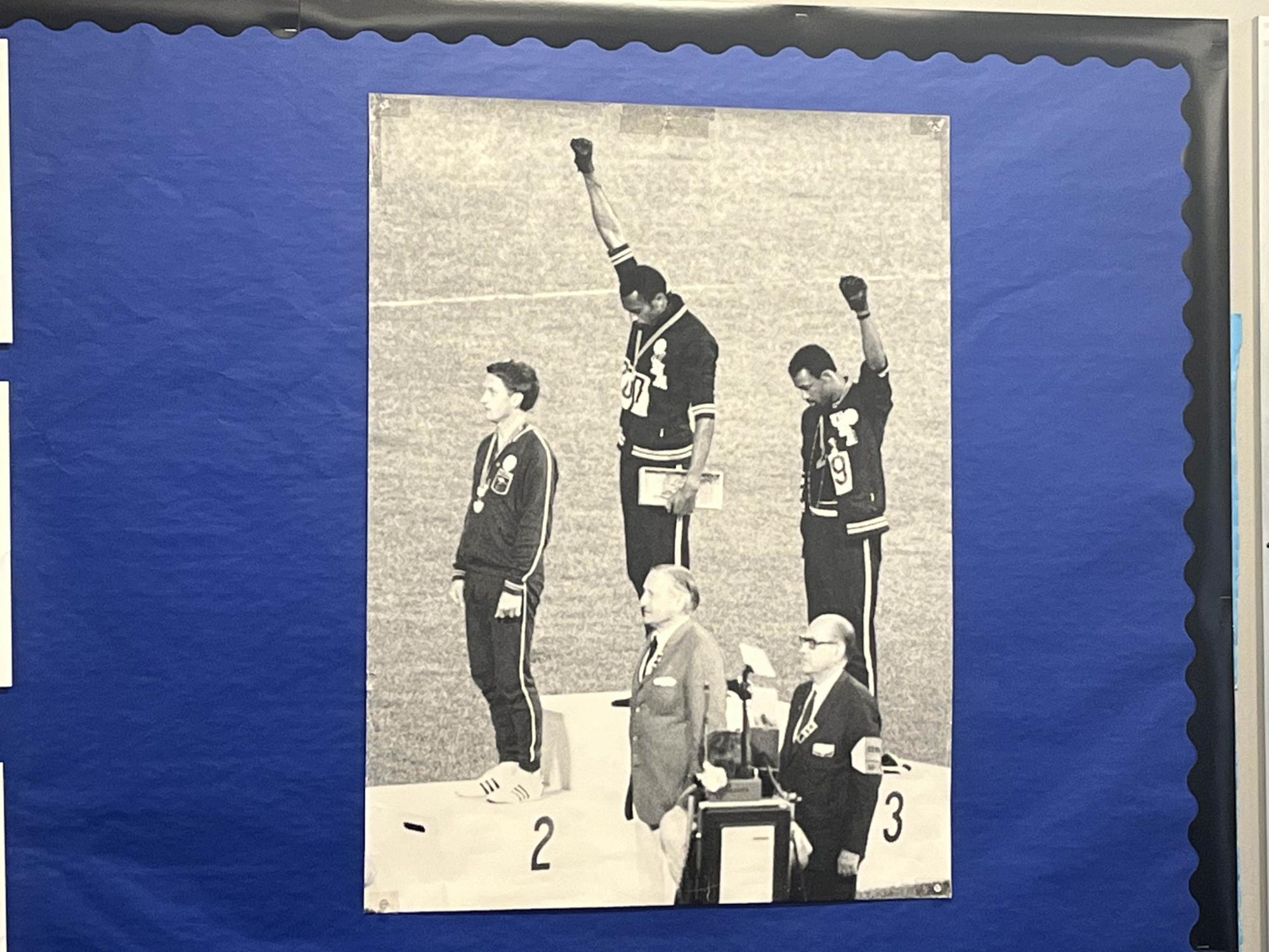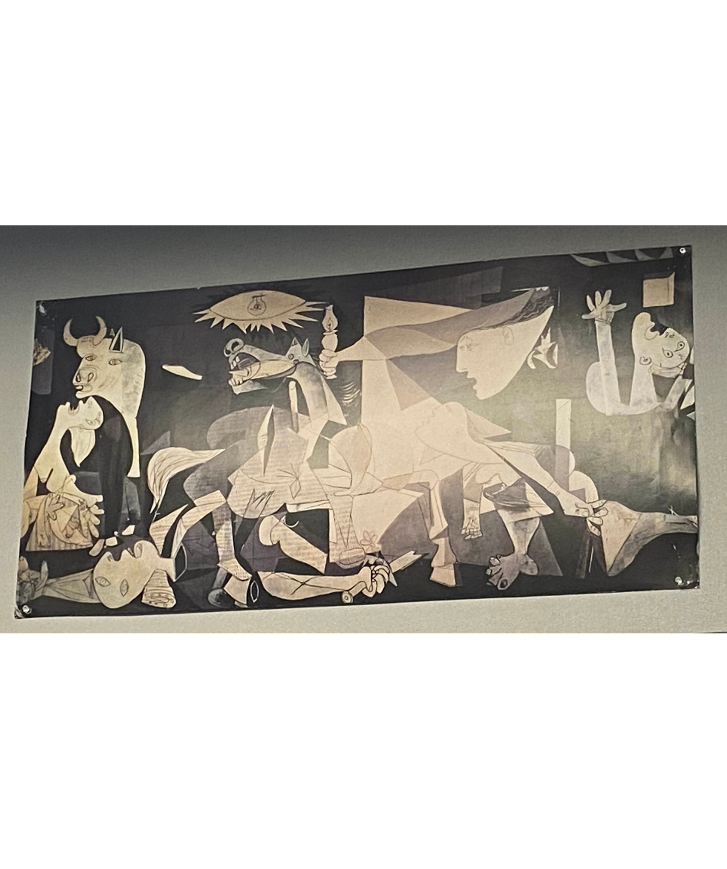- April 30The baller to beat
- April 29The First Congregational Church of Palo Alto brings 'Eras of Esther' to the stage
- April 29College bound
- April 29Supreme Court’s overturning of affirmative action may have substantial long term effects on admissions
- April 29Cupertino’s 40th annual Cherry Blossom Festival
- April 27Class of 2025 hosts AP Study Session
- April 26College by the numbers
- April 26Volume 54, Issue 6, April 25, 2024
- April 25March Madness comes to MVHS
- April 25‘Abigail’ bleeds its tired premise dry
One of the first things students notice in history teacher Usiel Meraz-Cerna’s classroom is the Libyan flag proudly displayed on the wall opposite the door, next to his desk.
The flag, with three horizontal stripes of red, black and green, and a white crescent and star at the center, is used to represent the cause of the revolutionaries in Libya under the dictatorship of Muammar Gaddafi.
According to Meraz-Cerna, most students may not recognize the flag; however, to him, it represents a very important aspect of his experiences teaching and living abroad. After Meraz-Cerna spent five years teaching in the Bay Area, he and his wife relocated abroad in 2010 to teach at a Libyan international school.
“It was a very interesting experience moving to a country where very few people spoke English,” Meraz-Cerna said. “They only spoke Arabic and some Italian due to the history of Italy in Libya. That was a whole new experience, like living in a totally different world."
Despite the language barrier and new environment, the friendliness of the Libyan people made the stay very comfortable and enjoyable. According to Meraz-Cerna, the Libyan people were very open to meeting foreigners, welcoming, hugging and inviting him for coffee whenever they heard him speaking English while walking down the streets.
“They were just really eager to meet outsiders because they had not been able to for so many years,” Meraz-Cerna said. “People from outside the country could not visit in past years so people were extremely friendly.”
The Arab Spring, a series of revolutions in the Middle East, erupted in the winter of 2010, during Meraz-Cerna’s stay there. In Libya, the people were demonstrating and revolting to overthrow dictator Muammar Gaddafi, and Meraz-Cerna and his wife were forced to hide and eventually evacuate through a US-sanctioned ferry.
“Everything was shut down,” Meraz-Cerna said. “Businesses shut down and the foreign companies started evacuating their workers, so we had to hide in the school while the war was raging around us. It was a scary moment.”
Eventually, through a barrage of storms at sea, Meraz-Cerna made it to the island of Malta, to safety. Even though he left at a time of violence and is still not able to return due to the chaos ensuing in Libya, Meraz-Cerna’s memories of the country are very fond, and he holds admiration for the revolutionaries and demonstrators there.
“I felt strong support for the rebels who were fighting for their freedom and fighting for a reform to not live under dictatorship anymore,” Meraz-Cerna said. “Now, I have this flag of Libya as a kind of a reminder of the revolution because the flag itself is revolutionary.”
On the back wall of Meraz-Cerna’s classroom hangs a poster of the 1968 Olympics Black Power salute.
As the Star Spangled Banner played, gold medalist Tommie Smith and bronze medalist John Carlos in the 200-meter running event raised their gloved hands, as opposed to putting their hands on the hearts, to protest for Black rights. This act resulted in the expulsion of the two from the Olympic Games — with their medals taken away and only reinstated decades later — but the protest was forever remembered.
Being a San Jose State University alum, Meraz-Cerna recalls seeing a statue of the event as the centerpiece of the university. Admiring the message of the act, he has had the poster in his classroom ever since he started teaching.
“You have to stand up for what you believe in and you have to stand up for what is right, even when there are unpleasant consequences,” Meraz-Cerna said. “Even when the entire world is looking at you, you have to do what is right, and you have to commit to that. I think the poster is a really good reminder of that.”
On the back wall of Meraz-Cerna’s classroom, Pablo Picasso’s painting Guernica is displayed. According to Meraz-Cerna, the abstract painting has a painful message behind the oversized heads and misshapen necks, depicting the Battle of Guernica in Spain.
“It is a painting intended to be a reminder of the horrors of war, to remind us to value peace more than anything, and that when innocent people are being massacred in war, it only ever results in suffering,” Meraz-Cerna said.
When he first saw Guernica in person at an art museum in Madrid, he remembers being overwhelmed and in awe at the size of it, describing it as “three times taller than him.”
“It was so impressive in its size and scale, which makes the emotion of it and the tragedy of it so much more real,” Meraz-Cerna said. “It left a big impression on me.”
Every so often, he points the painting out to his students to remind them of its significance.
All around the classroom are hints of Meraz-Cerna’s cultural identity — a sombrero, a sarape and a Mexican flag.
Meraz-Cerna’s sombrero is an item that is very personal to him, as it is the one that he has worn while performing Mexican folk dances, which range from indigenous dances from Mexico’s history to dances that use modern instruments like guitars and drums.
Another piece of Meraz-Cerna’s culture is found covering the table at the front of the room — a sarape.
“It is a kind of blanket that has been used in Mexico by the common and peasant classes,” Meraz-Cerna said. “It is something that I grew up with, and it is a way for me to put a personal touch in the classroom. Since I am here all day, every day, I want to feel at home.”
The Mexican flag, hung proudly above Meraz-Cerna’s desk, ties all his cultural details together. It is representative of where his family comes from, and he celebrates the fact wholeheartedly, apparent from the rich assemblage of cultural items in his classroom.
“Part of what these personal items do is validate the fact that we can all celebrate our culture,” Meraz-Cerna said. “Even though most of my students are not Mexican themselves, what I hope that they realize when they come in here is that celebrating and representing our culture is something that we can and should do on campus. It makes being here on campus more interesting, knowing that while we all have a shared kind of American culture, we can differentiate ourselves and still be rooted in the places and the lifestyles that our families come from.”






